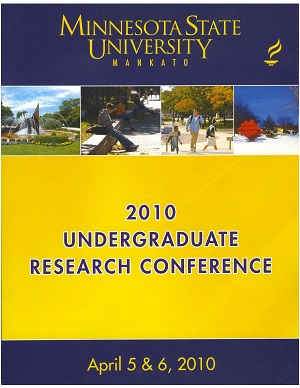Analysis of the CAG Trinucleotide Repeat in the Novel Polyglutamine Protein KIAA1946- Exclusion of this Genetic Locus as a Candidate Gene for Neurodegenerative Disease
Location
CSU 253/4/5
Start Date
5-4-2010 10:00 AM
End Date
5-4-2010 12:00 PM
Student's Major
Biological Sciences
Student's College
Science, Engineering and Technology
Mentor's Name
Geoffrey Goellner
Mentor's Department
Biological Sciences
Mentor's College
Science, Engineering and Technology
Description
In 1872, an American physician, George Huntington first described a condition, later named Huntington’s disease (HD), in which middle-aged, healthy, and competent adults experience a loss of control over bodily movement and function. In 1993, the causative mutation was found to be an expansion of a specific triplet repeat DNA sequence (CAG- which codes of amino acid glutamine) within the huntingtin gene.
Interestingly, the exact number of glutamines in the huntingtin gene normally varies from person to person; thus, it is polymorphic. However, expansion beyond the normal polymorphic range causes HD. Subsequently, a number of other severe neurodegenerative diseases have also been found to be
―polyglutamine‖ diseases. The recent completion of the human genome sequencing project has revealed other uncharacterized proteins with long glutamine stretches in their primary amino acid sequence. One such orphan gene is called KIAA1946. Using standard molecular biology techniques, such as PCR and DNA sequencing, we have investigated whether KIAA1946’s polyglutamine region is also polymorphic within the normal human population- and therefore a candidate gene for neurodegenerative disease. Preliminary results suggest that the glutamine stretch in KIAA1946 is in fact quite stable. Indeed, the most prevalent allele matches identically to the published sequence: CAA(CAG)8(CAA)5CAGCAA. Our results suggest that KIAA1946 should not be considered a strong candidate gene for neurodegenerative disorders not yet genetically characterized.
Analysis of the CAG Trinucleotide Repeat in the Novel Polyglutamine Protein KIAA1946- Exclusion of this Genetic Locus as a Candidate Gene for Neurodegenerative Disease
CSU 253/4/5
In 1872, an American physician, George Huntington first described a condition, later named Huntington’s disease (HD), in which middle-aged, healthy, and competent adults experience a loss of control over bodily movement and function. In 1993, the causative mutation was found to be an expansion of a specific triplet repeat DNA sequence (CAG- which codes of amino acid glutamine) within the huntingtin gene.
Interestingly, the exact number of glutamines in the huntingtin gene normally varies from person to person; thus, it is polymorphic. However, expansion beyond the normal polymorphic range causes HD. Subsequently, a number of other severe neurodegenerative diseases have also been found to be
―polyglutamine‖ diseases. The recent completion of the human genome sequencing project has revealed other uncharacterized proteins with long glutamine stretches in their primary amino acid sequence. One such orphan gene is called KIAA1946. Using standard molecular biology techniques, such as PCR and DNA sequencing, we have investigated whether KIAA1946’s polyglutamine region is also polymorphic within the normal human population- and therefore a candidate gene for neurodegenerative disease. Preliminary results suggest that the glutamine stretch in KIAA1946 is in fact quite stable. Indeed, the most prevalent allele matches identically to the published sequence: CAA(CAG)8(CAA)5CAGCAA. Our results suggest that KIAA1946 should not be considered a strong candidate gene for neurodegenerative disorders not yet genetically characterized.
Recommended Citation
Miller, Eric and Travis Mrkvicka. "Analysis of the CAG Trinucleotide Repeat in the Novel Polyglutamine Protein KIAA1946- Exclusion of this Genetic Locus as a Candidate Gene for Neurodegenerative Disease." Undergraduate Research Symposium, Mankato, MN, April 5, 2010.
https://cornerstone.lib.mnsu.edu/urs/2010/poster-session-A/17



